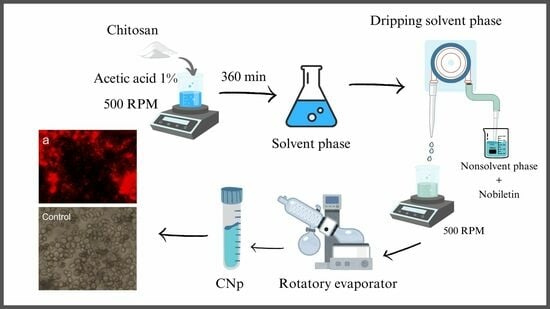Cellular Internalization and Toxicity of Chitosan Nanoparticles Loaded with Nobiletin in Eukaryotic Cell Models (Saccharomyces cerevisiae and Candida albicans)
Abstract
1. Introduction
2. Materials and Methods
2.1. Materials
2.2. Synthesis of CNp
2.3. DLS and ζ-Potential
2.4. Fourier-Transform Infrared Spectroscopy (FTIR)
2.5. Scanning Electron Microscopy (SEM)
2.6. Inoculum Reactivation
2.7. Nanoparticles Treatment Preparation
2.8. Cell Viability
2.9. Membrane Permeability Damage
2.10. Experimental Design and Statistical Analysis
3. Results
3.1. Hydrodynamic Diameter and ζ-Potential Analysis of CNp and CNpN
3.2. SEM Characterization and Morphological Analysis of CNp and CNpN
3.3. FTIR Spectra, Chitosan–Nobiletin Interaction
3.4. Effect of CNp and CNpN Treatments on the Viability of S. cerevisiae
3.5. Effect of CNp and CNpN Treatments on the Viability of C. albicans
3.6. Effect of CNp and CNpN Treatments on the Cell Membrane Integrity of S. cerevisiae
3.7. Effect of CNp and CNpN Treatments on the Cell Membrane Integrity of C. albicans
4. Conclusions
Author Contributions
Funding
Institutional Review Board Statement
Informed Consent Statement
Data Availability Statement
Acknowledgments
Conflicts of Interest
References
- Contera, S.; Bernardino de la Serna, J.; Tetley, T.D. Biotechnology, Nanotechnology and Medicine. Emerg. Top. Life Sci. 2020, 4, 551–554. [Google Scholar] [CrossRef] [PubMed]
- Malik, S.; Muhammad, K.; Waheed, Y. Emerging Applications of Nanotechnology in Healthcare and Medicine. Molecules 2023, 28, 6624. [Google Scholar] [CrossRef] [PubMed]
- Tang, W.; Wang, J.; Hou, H.; Li, Y.; Wang, J.; Fu, J.; Lu, L.; Gao, D.; Liu, Z.; Zhao, F.; et al. Review: Application of Chitosan and Its Derivatives in Medical Materials. Int. J. Biol. Macromol. 2023, 240, 124398. [Google Scholar] [CrossRef] [PubMed]
- Tian, B.; Liu, J. Smart Stimuli-Responsive Chitosan Hydrogel for Drug Delivery: A Review. Int. J. Biol. Macromol. 2023, 235, 123902. [Google Scholar] [CrossRef] [PubMed]
- Pragti; Kundu, B.K.; Singh, S.; Carlton Ranjith, W.A.; Sarkar, S.; Sonawane, A.; Mukhopadhyay, S. Chitosan–Biotin-Conjugated PH-Responsive Ru(II) Glucose Nanogel: A Dual Pathway of Targeting Cancer Cells and Self-Drug Delivery. ACS Appl. Mater. Interfaces 2023, 15, 43345–43358. [Google Scholar] [CrossRef] [PubMed]
- Murata, T.; Ishiwa, S.; Lin, X.; Nakazawa, Y.; Tago, K.; Funakoshi-Tago, M. The Citrus Flavonoid, Nobiletin Inhibits Neuronal Inflammation by Preventing the Activation of NF-ΚB. Neurochem. Int. 2023, 171, 105613. [Google Scholar] [CrossRef] [PubMed]
- Ijaz, M.; Ahmed, A.; Al-Ghanim, K.; Al-Misned, F.; Riaz, M.; Kaimkhani, Z.; Mahboob, S. Evaluation of the Possible Protective Role of Nobiletin against Arsenic-Induced Liver Damage in Male Albino Rats. Toxics 2023, 11, 110. [Google Scholar] [CrossRef] [PubMed]
- Jahan, S.; Ansari, U.A.; Srivastava, A.K.; Aldosari, S.; Alabdallat, N.G.; Siddiqui, A.J.; Khan, A.; Albadrani, H.M.; Sarkar, S.; Khan, B.; et al. A Protein–MiRNA Biomic Analysis Approach to Explore Neuroprotective Potential of Nobiletin in Human Neural Progenitor Cells (HNPCs). Front. Pharmacol. 2024, 15, 1343569. [Google Scholar] [CrossRef]
- Moazamiyanfar, R.; Rezaei, S.; AliAshrafzadeh, H.; Rastegar-Pouyani, N.; Jafarzadeh, E.; Mouludi, K.; Khodamoradi, E.; Zhaleh, M.; Taeb, S.; Najafi, M. Nobiletin in Cancer Therapy; Mechanisms and Therapy Perspectives. Curr. Pharm. Des. 2023, 29, 1713–1728. [Google Scholar] [CrossRef]
- Nguyen-Ngo, C.; Salomon, C.; Quak, S.; Lai, A.; Willcox, J.C.; Lappas, M. Nobiletin Exerts Anti-Diabetic and Anti-Inflammatory Effects in an In Vitro Human Model and In Vivo Murine Model of Gestational Diabetes. Clin. Sci. 2020, 134, 571–592. [Google Scholar] [CrossRef]
- Yamada, S.; Shirai, M.; Ono, K.; Teruya, T.; Yamano, A.; Tae Woo, J. Beneficial Effects of a Nobiletin-rich Formulated Supplement of Sikwasa (C. Depressa) Peel on Cognitive Function in Elderly Japanese Subjects; A Multicenter, Randomized, Double-blind, Placebo-controlled Study. Food Sci. Nutr. 2021, 9, 6844–6853. [Google Scholar] [CrossRef] [PubMed]
- Nakajima, A.; Ohizumi, Y. Potential Benefits of Nobiletin, A Citrus Flavonoid, against Alzheimer’s Disease and Parkinson’s Disease. Int. J. Mol. Sci. 2019, 20, 3380. [Google Scholar] [CrossRef] [PubMed]
- Kim, Y.-J.; Yoon, D.S.; Jung, U.J. Efficacy of Nobiletin in Improving Hypercholesterolemia and Nonalcoholic Fatty Liver Disease in High-Cholesterol Diet-Fed Mice. Nutr. Res. Pract. 2021, 15, 431. [Google Scholar] [CrossRef] [PubMed]
- Luque-Alcaraz, A.G.; Lizardi, J.; Goycoolea, F.M.; Valdez, M.A.; Acosta, A.L.; Iloki-Assanga, S.B.; Higuera-Ciapara, I.; Argüelles-Monal, W. Characterization and Antiproliferative Activity of Nobiletin-Loaded Chitosan Nanoparticles. J. Nanomater. 2012, 2012, 265161. [Google Scholar] [CrossRef]
- Zhang, W.; Taheri-Ledari, R.; Ganjali, F.; Mirmohammadi, S.S.; Qazi, F.S.; Saeidirad, M.; KashtiAray, A.; Zarei-Shokat, S.; Tian, Y.; Maleki, A. Effects of Morphology and Size of Nanoscale Drug Carriers on Cellular Uptake and Internalization Process: A Review. RSC Adv. 2023, 13, 80–114. [Google Scholar] [CrossRef] [PubMed]
- Shi, H.; Jiang, Y.; Yang, Y.; Peng, Y.; Li, C. Copper Metabolism in Saccharomyces Cerevisiae: An Update. BioMetals 2021, 34, 3–14. [Google Scholar] [CrossRef]
- Robinson, J.R.; Isikhuemhen, O.S.; Anike, F.N. Fungal–Metal Interactions: A Review of Toxicity and Homeostasis. J. Fungi. 2021, 7, 225. [Google Scholar] [CrossRef] [PubMed]
- Peng, Y.; Chen, B. Role of Cell Membrane Homeostasis in the Pathogenicity of Pathogenic Filamentous Fungi. Virulence 2024, 15, 2299183. [Google Scholar] [CrossRef]
- Gálvez-Iriqui, A.C.; García-Romo, J.S.; Cortez-Rocha, M.O.; Burgos-Hernández, A.; Burboa-Zazueta, M.G.; Luque-Alcaraz, A.G.; Calderón-Santoyo, M.; Argüelles-Monal, W.M.; Plascencia-Jatomea, M. Phytotoxicity, Cytotoxicity, and In Vivo Antifungal Efficacy of Chitosan Nanobiocomposites on Prokaryotic and Eukaryotic Cells. Environ. Sci. Pollut. Res. 2021, 28, 3051–3065. [Google Scholar] [CrossRef]
- Dananjaya, S.H.S.; Kulatunga, D.C.M.; Godahewa, G.I.; Nikapitiya, C.; Oh, C.; Edussuriya, M.; Lee, J.; De Zoysa, M. Preparation, Characterization, and Antimicrobial Properties of Chitosan–Silver Nanocomposites Films Against Fish Pathogenic Bacteria and Fungi. Indian. J. Microbiol. 2017, 57, 427–437. [Google Scholar] [CrossRef]
- Liu, J.; Xiao, Y.; Wang, Y.; Qin, X.; Tan, S.; Wang, W.; Lou, L.; Wu, Z.; Aihaiti, A.; Ma, C.; et al. The Inhibition Effect and Mechanism of Nano Magnesium Peroxide Against Spoilage Fungi Emerging in Hami Melon. Food Bioproc. Tech. 2023, 16, 2027–2038. [Google Scholar] [CrossRef]
- Pham, X.N.; Nguyen, T.P.; Pham, T.N.; Tran, T.T.N.; Tran, T.V.T. Synthesis and Characterization of Chitosan-Coated Magnetite Nanoparticles and Their Application in Curcumin Drug Delivery. Adv. Nat. Sci. Nanosci. Nanotechnol. 2016, 7, 045010. [Google Scholar] [CrossRef]
- Li, S.-Z.; Zhang, N.-N.; Yang, X.; Huang, T.-Q.; Lin, Y.; Jiang, Z.-M.; Yi, Y.; Liu, E.-H. Nobiletin Ameliorates Nonalcoholic Fatty Liver Disease by Regulating Gut Microbiota and Myristoleic Acid Metabolism. J. Agric. Food Chem. 2023, 71, 7312–7323. [Google Scholar] [CrossRef]
- Hao, Y.; Xiang, Q.; Ye, Z.; Feng, D.; Ye, H.; He, S.; Liao, W. Beneficial Effects of Nobiletin on Regulation of Lipid Metabolism. Food Biosci. 2024, 57, 103484. [Google Scholar] [CrossRef]
- Luque-Alcaraz, A.G.; Lizardi-Mendoza, J.; Goycoolea, F.M.; Higuera-Ciapara, I.; Argüelles-Monal, W. Preparation of Chitosan Nanoparticles by Nanoprecipitation and Their Ability as a Drug Nanocarrier. RSC Adv. 2016, 6, 59250–59256. [Google Scholar] [CrossRef]
- Hernández, P.; Lucero-Acuña, A.; Gutiérrez-Valenzuela, C.A.; Moreno, R.; Esquivel, R. Systematic Evaluation of PH and Thermoresponsive Poly(n-Isopropylacrylamide-Chitosan-Fluorescein) Microgel. e-Polymers 2017, 17, 399–408. [Google Scholar] [CrossRef]
- Rafiee, A.; Mozafari, N.; Fekri, N.; Memarpour, M.; Azadi, A. Preparation and Characterization of a Nanohydroxyapatite and Sodium Fluoride Loaded Chitosan-Based in Situ Forming Gel for Enamel Biomineralization. Heliyon 2024, 10, e24217. [Google Scholar] [CrossRef]
- Rahman, M.M.; Maniruzzaman, M. A New Route of Production of the Meso-Porous Chitosan with Well-Organized Honeycomb Surface Microstructure from Shrimp Waste without Destroying the Original Structure of Native Shells: Extraction, Modification and Characterization Study. Results Eng. 2023, 19, 101362. [Google Scholar] [CrossRef]
- Wijesena, R.N.; Tissera, N.; Kannangara, Y.Y.; Lin, Y.; Amaratunga, G.A.J.; de Silva, K.M.N. A Method for Top down Preparation of Chitosan Nanoparticles and Nanofibers. Carbohydr. Polym. 2015, 117, 731–738. [Google Scholar] [CrossRef]
- Tamer, T.M.; ElTantawy, M.M.; Brussevich, A.; Nebalueva, A.; Novikov, A.; Moskalenko, I.V.; Abu-Serie, M.M.; Hassan, M.A.; Ulasevich, S.; Skorb, E.V. Functionalization of Chitosan with Poly Aromatic Hydroxyl Molecules for Improving Its Antibacterial and Antioxidant Properties: Practical and Theoretical Studies. Int. J. Biol. Macromol. 2023, 234, 123687. [Google Scholar] [CrossRef]
- Chávez-Magdaleno, M.E.; Luque-Alcaraz, A.G.; Gutierrez-Martınez, P.; Cortez-Rocha, M.O.; Burgos-Hernandez, A.; Lizardi-Mendoza, J.; Plascencia-Jatomea, M. Effect of chitosan-pepper tree (Schinus molle) essential oil biocomposites on the growth kinetics, viability and membrane integrity of Colletotrichum Gloeosporioides. Rev. Mex. Ing. Quim. 2017, 17, 29–45. [Google Scholar] [CrossRef]
- Plascencia-Jatomea, M.; Cortez-Rocha, M.O.; Rodríguez-Félix, F.; Mouriño-Pérez, R.R.; Lizardi-Mendoza, J.; Sánchez-Maríñez, R.I.; López-Meneses, A.K. Synthesis and Toxicological Study of Chitosan–Pirul (Schinus Molle L.) Essential Oil Nanoparticles on Aspergillus Flavus. Arch. Microbiol. 2024, 206, 133. [Google Scholar] [CrossRef]
- Gálvez-Iriqui, A.C.; Cortez-Rocha, M.O.; Burgos-Hernández, A.; Calderón-Santoyo, M.; Argüelles-Monal, W.M.; Plascencia-Jatomea, M. Synthesis of Chitosan Biocomposites Loaded with Pyrrole-2-Carboxylic Acid and Assessment of Their Antifungal Activity against Aspergillus Niger. Appl. Microbiol. Biotechnol. 2019, 103, 2985–3000. [Google Scholar] [CrossRef] [PubMed]
- Peña, A.; Sánchez, N.S.; Calahorra, M. Effects of Chitosan on Candida Albicans: Conditions for Its Antifungal Activity. Biomed. Res. Int. 2013, 2013, 527549. [Google Scholar] [CrossRef] [PubMed]
- Zakrzewska, A.; Boorsma, A.; Delneri, D.; Brul, S.; Oliver, S.G.; Klis, F.M. Cellular Processes and Pathways That Protect Saccharomyces cerevisiae Cells against the Plasma Membrane-Perturbing Compound Chitosan. Eukaryot. Cell 2007, 6, 600–608. [Google Scholar] [CrossRef] [PubMed]
- Ing, L.Y.; Zin, N.M.; Sarwar, A.; Katas, H. Antifungal Activity of Chitosan Nanoparticles and Correlation with Their Physical Properties. Int. J. Biomater. 2012, 2012, 632698. [Google Scholar] [CrossRef] [PubMed]
- Kong, M.; Chen, X.G.; Xing, K.; Park, H.J. Antimicrobial Properties of Chitosan and Mode of Action: A State of the Art Review. Int. J. Food Microbiol. 2010, 144, 51–63. [Google Scholar] [CrossRef]
- Manzanares, D.; Ceña, V. Endocytosis: The Nanoparticle and Submicron Nanocompounds Gateway into the Cell. Pharmaceutics 2020, 12, 371. [Google Scholar] [CrossRef]
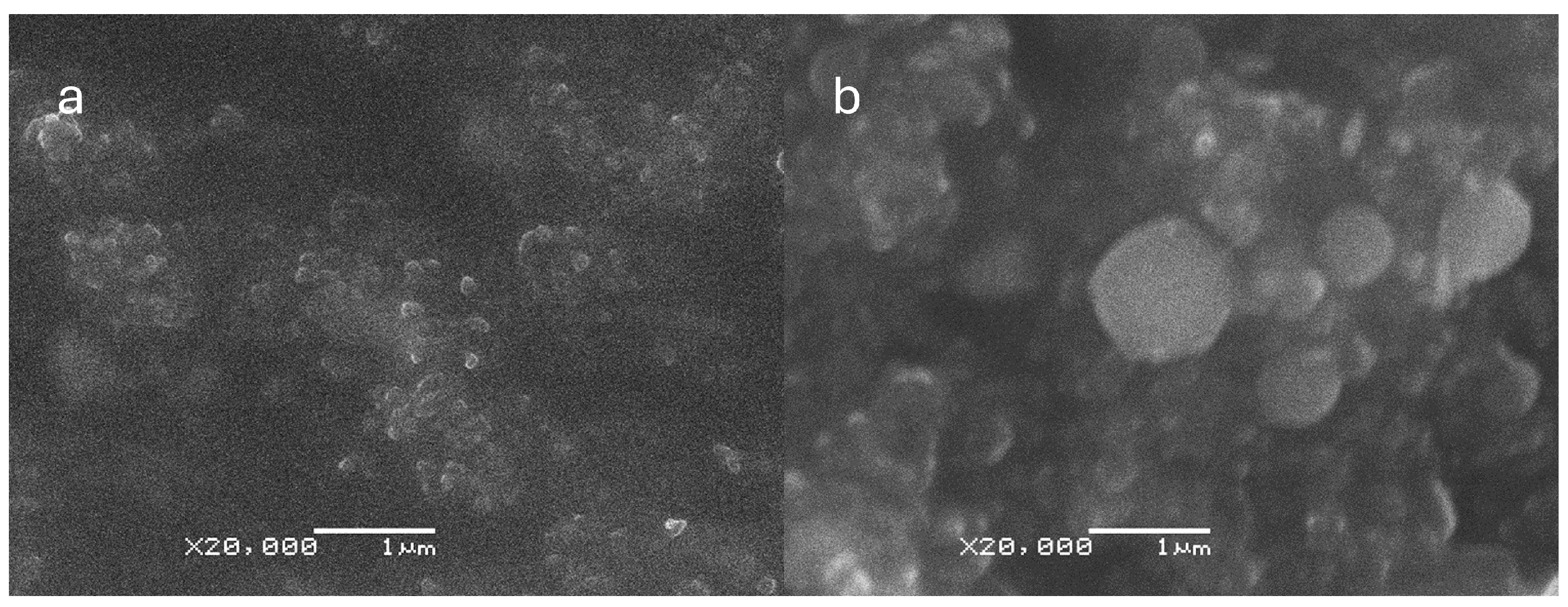
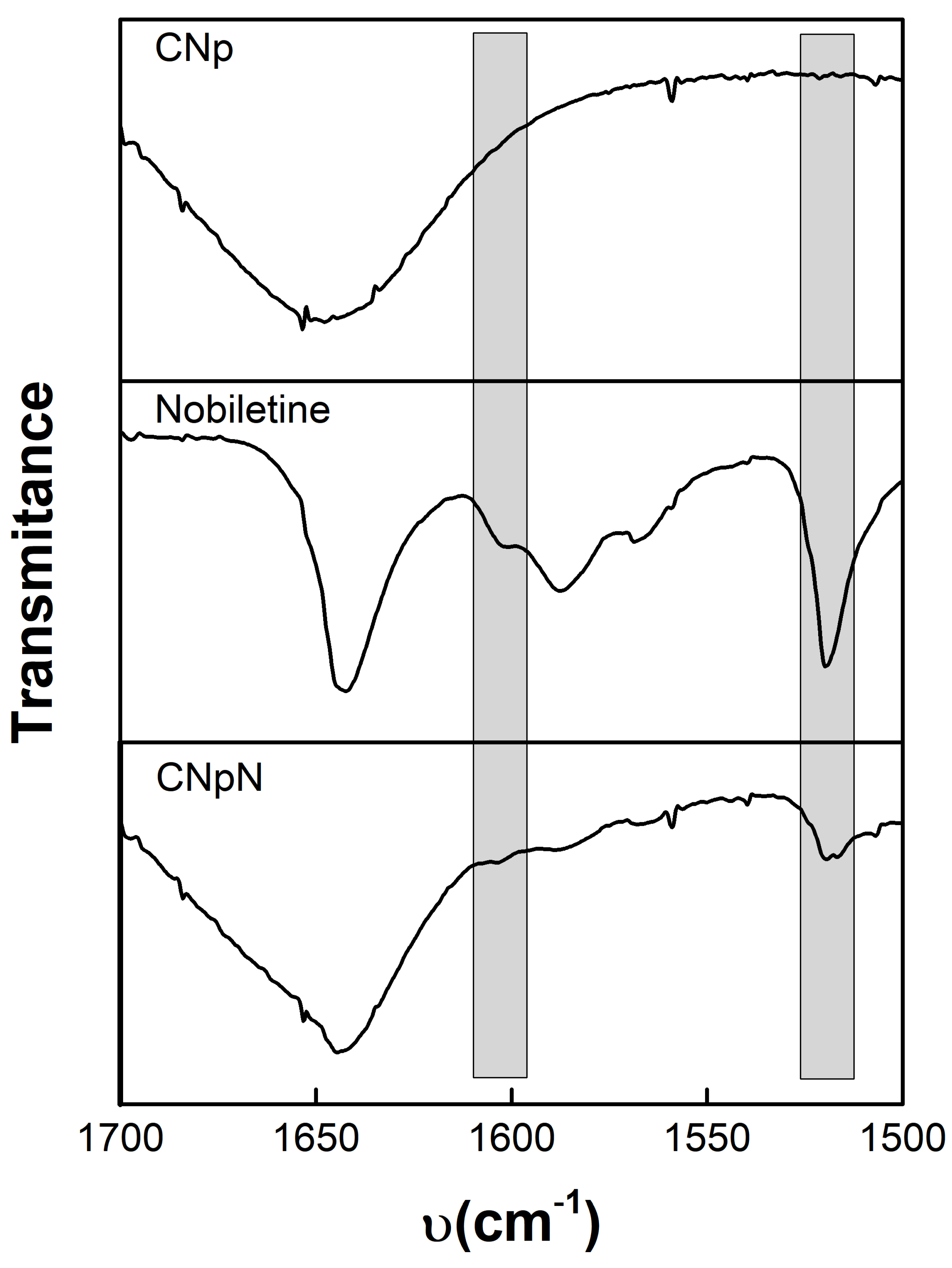
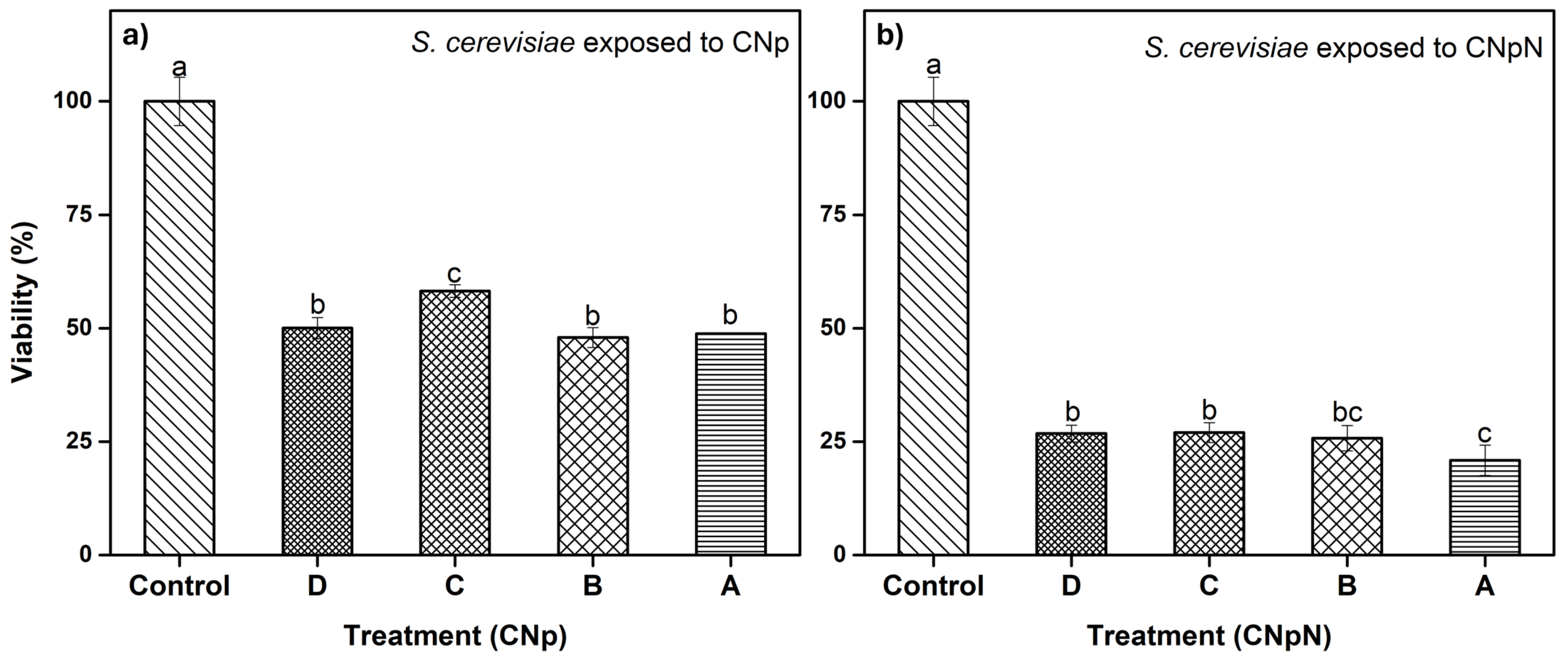
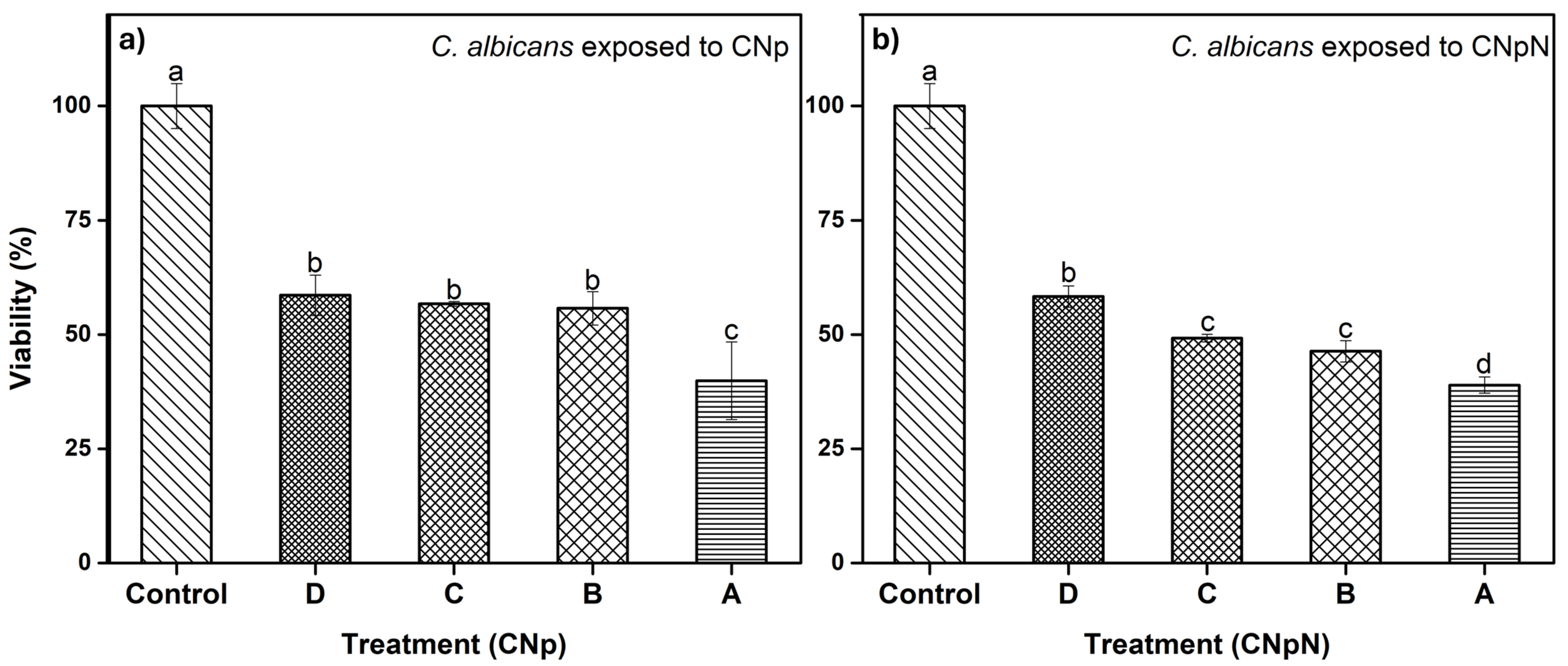
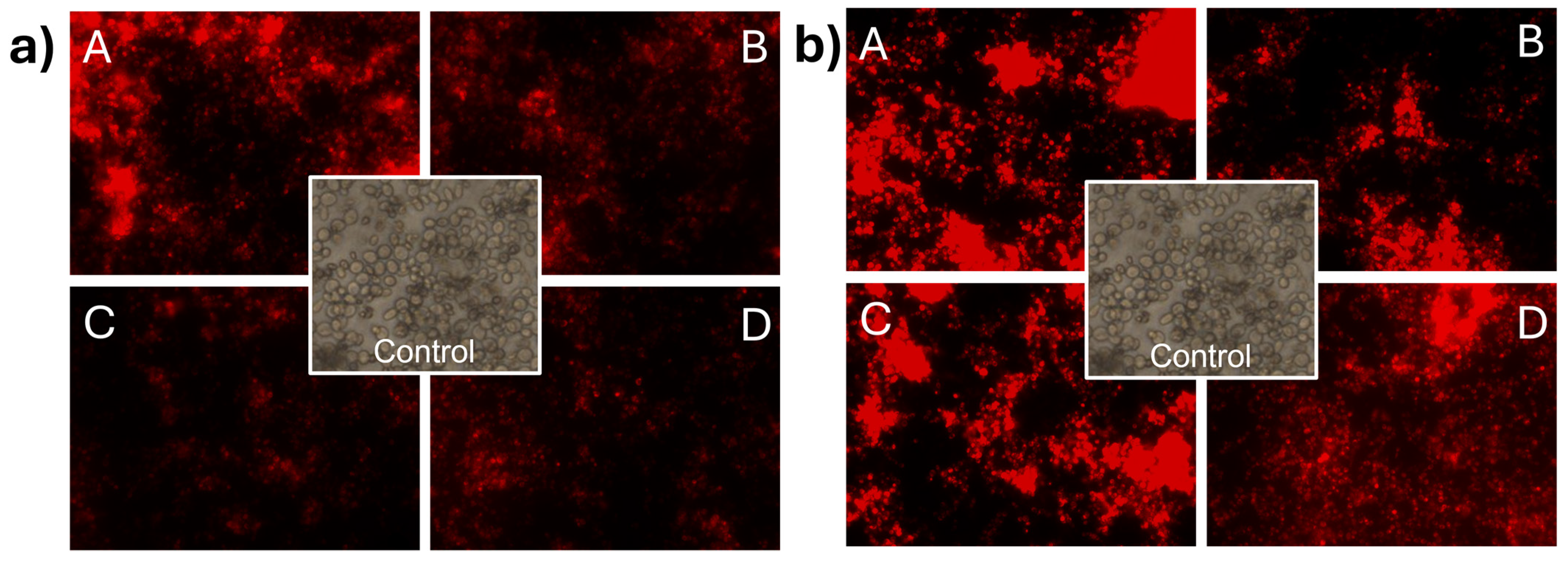
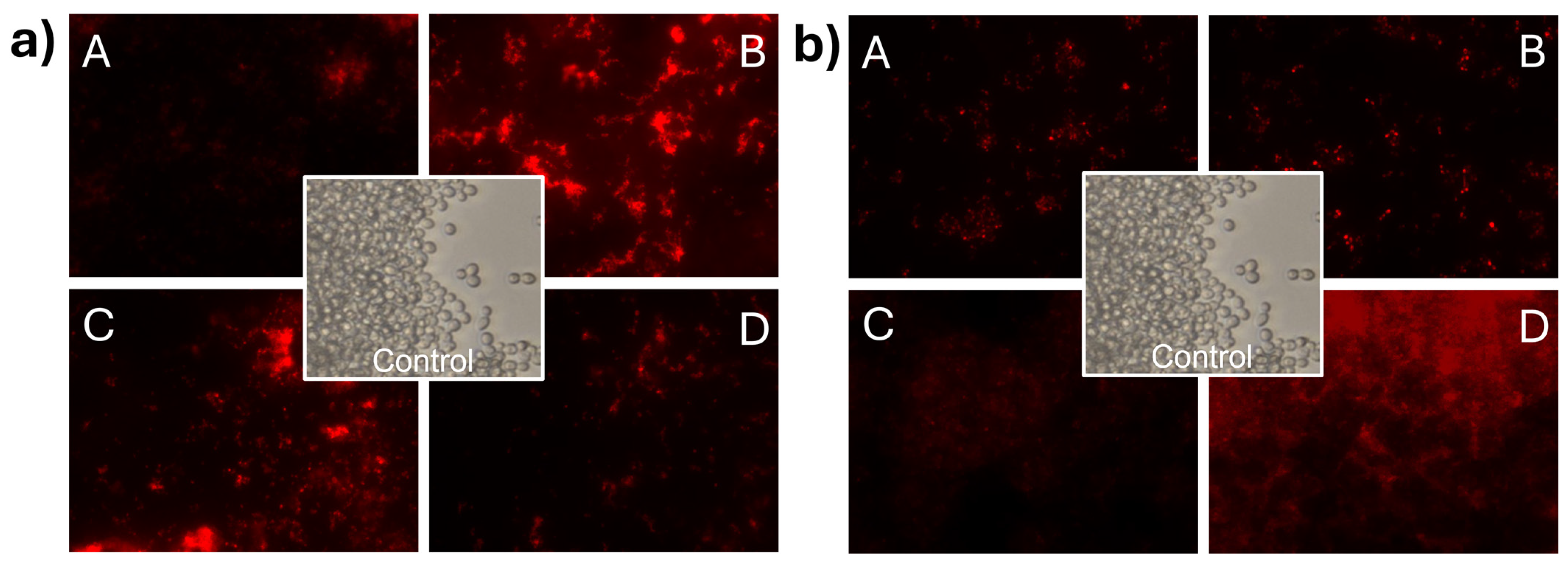
| Treatment | CNp | CNpN | Concentration |
|---|---|---|---|
| A | 418.8 μL CNP + 4581.15 mL PDB | 1.29 mL CNpN + 3.71 mL PDB | 0.16 mg/mL |
| B | 2.5 mL de A + 2.5 mL PDB | 2.5 mL de A + 2.5 mL PDB | 0.08 mg/mL |
| C | 2.5 mL de B + 2.5 mL PDB | 2.5 mL de B + 2.5 mL PDB | 0.04 mg/mL |
| D | 2.5 mL de C + 2.5 mL PDB | 2.5 mL de C + 2.5 mL PDB | 0.02 mg/mL |
| Control | 5 mL PDB | 5 mL PDB | 0.00 mg/mL |
| CNp | CNpN | |
|---|---|---|
| Hydrodynamic diameter (nm) | 288.74 ± 2.37 | 596.60 ± 35.49 |
| ζ-Potential (mV) | 34.51 ± 0.66 | 37.73 ± 0.19 |
Disclaimer/Publisher’s Note: The statements, opinions and data contained in all publications are solely those of the individual author(s) and contributor(s) and not of MDPI and/or the editor(s). MDPI and/or the editor(s) disclaim responsibility for any injury to people or property resulting from any ideas, methods, instructions or products referred to in the content. |
© 2024 by the authors. Licensee MDPI, Basel, Switzerland. This article is an open access article distributed under the terms and conditions of the Creative Commons Attribution (CC BY) license (https://creativecommons.org/licenses/by/4.0/).
Share and Cite
Hernández-Abril, P.A.; López-Meneses, A.K.; Lizardi-Mendoza, J.; Plascencia-Jatomea, M.; Luque-Alcaraz, A.G. Cellular Internalization and Toxicity of Chitosan Nanoparticles Loaded with Nobiletin in Eukaryotic Cell Models (Saccharomyces cerevisiae and Candida albicans). Materials 2024, 17, 1525. https://doi.org/10.3390/ma17071525
Hernández-Abril PA, López-Meneses AK, Lizardi-Mendoza J, Plascencia-Jatomea M, Luque-Alcaraz AG. Cellular Internalization and Toxicity of Chitosan Nanoparticles Loaded with Nobiletin in Eukaryotic Cell Models (Saccharomyces cerevisiae and Candida albicans). Materials. 2024; 17(7):1525. https://doi.org/10.3390/ma17071525
Chicago/Turabian StyleHernández-Abril, Pedro Amado, Ana Karenth López-Meneses, Jaime Lizardi-Mendoza, Maribel Plascencia-Jatomea, and Ana Guadalupe Luque-Alcaraz. 2024. "Cellular Internalization and Toxicity of Chitosan Nanoparticles Loaded with Nobiletin in Eukaryotic Cell Models (Saccharomyces cerevisiae and Candida albicans)" Materials 17, no. 7: 1525. https://doi.org/10.3390/ma17071525
APA StyleHernández-Abril, P. A., López-Meneses, A. K., Lizardi-Mendoza, J., Plascencia-Jatomea, M., & Luque-Alcaraz, A. G. (2024). Cellular Internalization and Toxicity of Chitosan Nanoparticles Loaded with Nobiletin in Eukaryotic Cell Models (Saccharomyces cerevisiae and Candida albicans). Materials, 17(7), 1525. https://doi.org/10.3390/ma17071525









